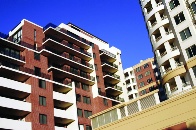The average asking price for an Auckland apartment has doubled in five years and a record number a due to be completed in 2018, new figures show

Back in March 2012, your typical Auckland apartment would cost you $313,000 but fast-forward five years to today and the average asking price has more than doubled at $631,450, according to the latest Trade Me Property Price Index.
“Auckland apartments have reached another record high of $631,450, and outperformed both units (up 72%) and small houses (up 82%) over the last five years,” said Head of Trade Me Property Nigel Jeffries.
“It seems, in Auckland at least, that Kiwis are getting over their aversion to apartment living. I suspect some of that is because they’ve been forced to reset their expectations, and apartments are seen as the most affordable way onto the property ladder.”
A record number of apartments are due to be completed in the super city over the next two years, the latest biannual Colliers International Auckland Residential Development Report shows.
About 2770 apartments in Auckland have a 2017 completion date – the greatest number since the 2005 peak, when 3600 apartments were finished.
Even more apartments are due to be finished next year, with a record-breaking 3840 apartments due to be completed in 2018.
Colliers International Research and Consulting national director Alan McMahon said the peak comes despite constraints on the sector including increasing building costs and a tight labour market.
“There’s no doubt it’s a challenging time for residential development, but it’s pleasing to see the sector is delivering results,” he said.
McMahon said the biggest obstacles facing developers are project costs and the construction industry’s capacity.
“The supply and demand imbalance may have worked in developers’ favour by boosting sales prices at a time of high demand, but now a shortage of high rise construction industry capacity is working against them.
“Building prices are up and projects are being pushed out in duration. There’s talk of easing those pressures with pre-fabrication and the large-scale use of imported skills, but so far no significant improvement is evident.”
McMahon said one solution could come from the banks, an unlikely source, whose tightening of credit to the property sector will lead to fewer projects going ahead.
“That could partially ease the escalation of construction costs, but the reduction in new apartment numbers will do nothing to address the residential supply and demand imbalance.”
He expects asking prices will keep rising, but not all developments will succeed.
“Buyers are becoming more discerning. They recognise quality and won’t pay the asking price unless they perceive it is good value,” he said.
“Tightened bank financing to developers, and constrained construction industry capacity, are combining to reduce future supply, which at a time of high demand will tend to push prices up.”
“Auckland apartments have reached another record high of $631,450, and outperformed both units (up 72%) and small houses (up 82%) over the last five years,” said Head of Trade Me Property Nigel Jeffries.
“It seems, in Auckland at least, that Kiwis are getting over their aversion to apartment living. I suspect some of that is because they’ve been forced to reset their expectations, and apartments are seen as the most affordable way onto the property ladder.”
A record number of apartments are due to be completed in the super city over the next two years, the latest biannual Colliers International Auckland Residential Development Report shows.
About 2770 apartments in Auckland have a 2017 completion date – the greatest number since the 2005 peak, when 3600 apartments were finished.
Even more apartments are due to be finished next year, with a record-breaking 3840 apartments due to be completed in 2018.
Colliers International Research and Consulting national director Alan McMahon said the peak comes despite constraints on the sector including increasing building costs and a tight labour market.
“There’s no doubt it’s a challenging time for residential development, but it’s pleasing to see the sector is delivering results,” he said.
McMahon said the biggest obstacles facing developers are project costs and the construction industry’s capacity.
“The supply and demand imbalance may have worked in developers’ favour by boosting sales prices at a time of high demand, but now a shortage of high rise construction industry capacity is working against them.
“Building prices are up and projects are being pushed out in duration. There’s talk of easing those pressures with pre-fabrication and the large-scale use of imported skills, but so far no significant improvement is evident.”
McMahon said one solution could come from the banks, an unlikely source, whose tightening of credit to the property sector will lead to fewer projects going ahead.
“That could partially ease the escalation of construction costs, but the reduction in new apartment numbers will do nothing to address the residential supply and demand imbalance.”
He expects asking prices will keep rising, but not all developments will succeed.
“Buyers are becoming more discerning. They recognise quality and won’t pay the asking price unless they perceive it is good value,” he said.
“Tightened bank financing to developers, and constrained construction industry capacity, are combining to reduce future supply, which at a time of high demand will tend to push prices up.”



